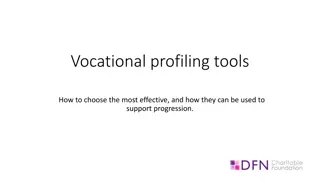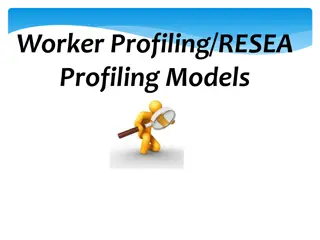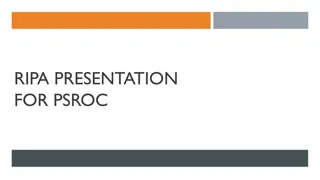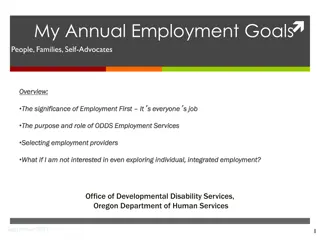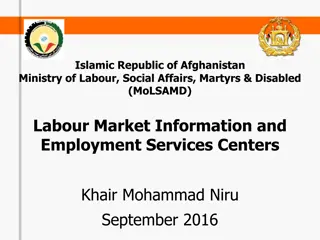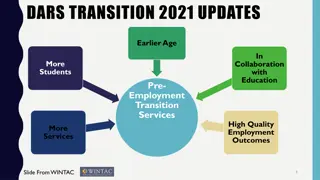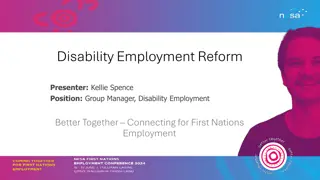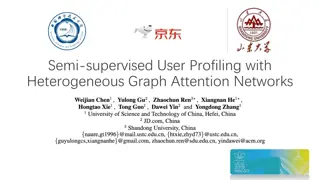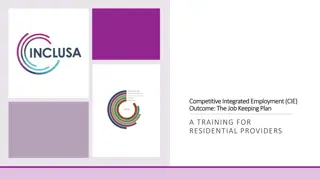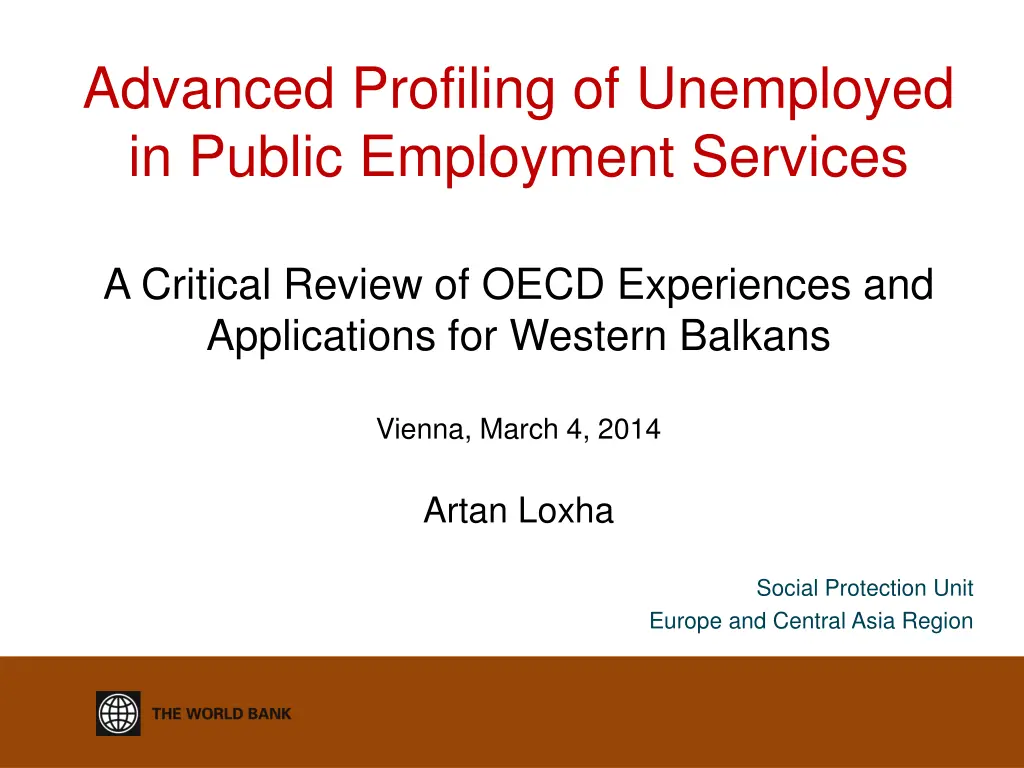
Critical Review of Profiling Methods for Unemployed in Public Employment Services
Discover the best practice profiling methods and key elements of activation for unemployed individuals in public employment services, as examined in the OECD context. Explore the traditional and reinvented roles of Public Employment Services (PES) in enhancing job search effectiveness and income support for job seekers.
Download Presentation

Please find below an Image/Link to download the presentation.
The content on the website is provided AS IS for your information and personal use only. It may not be sold, licensed, or shared on other websites without obtaining consent from the author. If you encounter any issues during the download, it is possible that the publisher has removed the file from their server.
You are allowed to download the files provided on this website for personal or commercial use, subject to the condition that they are used lawfully. All files are the property of their respective owners.
The content on the website is provided AS IS for your information and personal use only. It may not be sold, licensed, or shared on other websites without obtaining consent from the author.
E N D
Presentation Transcript
Advanced Profiling of Unemployed in Public Employment Services A Critical Review of OECD Experiences and Applications for Western Balkans Vienna, March 4, 2014 Artan Loxha Social Protection Unit Europe and Central Asia Region
Outline 1. Profiling in the context of activation 1. Best practice profiling methods in OECD 1. Statistical profiling and applications 1. Relevance for Western Balkans
Outline 1. Profiling in the context of activation 1. Best practice profiling methods in OECD 1. Statistical profiling and applications 1. Relevance for Western Balkans
Key elements of activation Key elements of effective activation Mutual obligations principle Activation models Enhanced responsibilities of the unemployed - Active job search and availability for work in return for income support - Individualized action-planning Restricted ALMPs to incentivize jobseeker Liberal model - Focus on high risk prioritization Social democratic model Operationalizing legislation through 4 main elements of activation - Service integration between PES and SA Extensive services and high benefit levels and coverage Provision of income support - Access to income support and to public employment services Continental corporatist model - Enhanced performance- based sub- contracting Individual responsibility to mobilize own assets, with key state role 4
The traditional role of the PES Interventions HIGH Intensive counseling and special ALMPs Level of prioritization by caseworker Vocational training Self-service and job matching Traditional PES client: the unemployed LOW 1 Income support/Job matching Time 5
Reinventing the role of PES in the context activation Early interventions Interventions 2 HIGH HIGH Intensive counseling and special ALMPs Level of prioritization by Distance from labor market High risk group caseworker 1 LOW Work-able vulnerable population Vocational training Middle risk group Self-service and job matching Low risk group Traditional PES client: the unemployed LOW 1 Income support/Job matching Time 6
Main uses of profiling $ Interventions Caseworker 2 HIGH HIGH Intensive counseling and special ALMPs Redistributing resources based on severity of profile Distance from labor market Level of prioritization by High risk group 3 1 LOW caseworker Vulnerable work-able population Vocational training Referral Middle risk group Self-service and job matching Low risk group LOW Client segmentation Targeting Resource planning 7
Profiling involves certain information asymmetries Caseworker Interventions 2 HIGH HIGH Intensive counseling and special ALMPs Distance from labor market Level of prioritization by High risk group 3 1 LOW caseworker Vulnerable work-able population Vocational training Referral Middle risk group Self-service and job matching Low risk group LOW Information asymmetries 8
Outline 1. Profiling in the context of activation 1. Best practice profiling methods in OECD 1. Statistical profiling and applications 1. Relevance for Western Balkans
Approach for studying OECD best practices Partner with Public Employment Services (PES) in OECD countries to capture best practices on jobseeker profiling 1: Stock-taking Identify models that could be applicable to Europe and Central Asia (ECA) PES, and test them through analysis of administrative data 2: Adaptation 3: Sharing with clients Share knowledge with PES in ECA region and explore possible pilots Enhance knowledge of all stakeholders through a Knowledge Brief, analytical paper, and conference 4: Dissemination 10
Methodology Desk research Countries PES material Study tour Ireland, Department of Social Protection (selected examples) Technical description of JSCI (AUS) Employee- focused Integration concept (GE) The Dutch Work Profiler (NL) Slovenian profiling system (SL) OECD activation country notes EU PES-to-PES dialogue papers Country-specific papers on profiling Selected academic papers Methodological notes on statistical profiling Australia Canada Denmark Finland Germany Ireland Netherlands Slovenia South Korea USA Sweden Switzerland Denmark, National Labor Authority Sweden, Public Employment Service 11
Key approaches to profiling in OECD Approaches Description Pros/Cons Country examples Profiling and referral done primarily by the caseworker Pros: individual needs German 4-phase model Caseworker-based segmentation Cons: subjective assessment Segmentation based on threshold in length of unemployment spell Pros: straightforward Ireland s wait-and-see approach prior to the crisis Time-based segmentation Cons: resource waste, ignores heterogeneity. Segmentation based on eligibility criteria Pros: straightforward Swedish Youth Job Program Demographic segmentation Cons: ignores heterogeneity Segmentation based on statistical analysis using MIS data Pros: ex-ante equal treatment, early interv., resource rationing USA s Worker Profiling and Reemployment Services Statistical segmentation Cons: misidentification Irish profiling system Evaluation using behavioral assessment tools Pros: greater private information German Kompetenzdiagnostik (competence diagnostics) Behavioral segmentation Cons: subjective 12
Classifying profiling systems Degree of caseworker discretion Complexity of data flow and processing 13
1. Data availability and processing Basic demographics Labor market data Complex data - - - - Employment status Duration Special needs Qualifications - - - - - Personal ID Age Gender Children Education level - - - - Soft and hard skills Motivation Behavior Health Complexity of data and processing 14
2. Degree of caseworker discretion HIGH - - - - - More likely to rely on caseworker-based diagnostics for segmenting jobseekers Caseworker resistance to automation may be higher More time-intensive and resource intensive Requires higher capacity However, caseworker s discretion can be curtailed depending on how binding data processing is to their decision-making Degree of caseworker discretion - More likely to rely on administrative rules and regulations for segmenting jobseekers - Less caseworker resistance to introducing other analytical tools may help address different constraints LOW 15
Classifying profiling systems HIGH Degree of caseworker discretion Data-assisted profiling Caseworker-based profiling Data-only profiling Rules-based profiling Complexity of data flow and processing LOW HIGH LOW 16
Key trade-offs HIGH Degree of caseworker discretion Data-assisted profiling Caseworker-based profiling caseworkers resistance to caseworker automation Invest in more Higher Data-only profiling Rules-based profiling Invest in data acquisition Complexity of data flow and processing LOW HIGH LOW 17
Outline 1. Profiling in the context of activation 1. Best practice profiling methods in OECD 1. Statistical profiling and applications 1. Relevance for Western Balkans
Statistical profiling: segmenting clients based on likelihood of work-resumption work-resumption Outcomes HIGH Risk of remaining long-term 100 Little chance of reemployment Better chance of reemployment Improved chance of reemployment Profiling model: Data input: unemployed - - MIS Ad-hoc extra data - Binary or duration models 2 1 Best chance of reemployment LOW
Intervention strategies by client profile and support intensity Far Client Distance from Labour Market Missed opportunities Frequency of Intervention Better chance of reemployment Directive Guidance Improved chance of reemployment Reference to Personal Development Job Search Wasted resources Best chance of reemployment Self-Serve Near High Low 21 Intensity of Support
Ireland: statistical profiling for case management intensity
Sweden: statistical profiling for ALMP prioritization Segmentation based on risk groups Registration and initial interview Statistical profiling model Final caseworker decision GROUP 1 Very good employment prospects GROUP 2 Good employment prospects Assessment Support Tool 2 1 Registration GROUP 3 Weak employment prospects Caseworker likely to override regular procedures and provide early ALMP interventions GROUP 4 3 At high risk of LTU; early ALMP measures needed 23
Australia: statistical profiling for steering private contractors 25
Australia: statistical profiling for steering private contractors 26
Outline 1. Profiling in the context of activation 1. Best practice profiling methods in OECD 1. Statistical profiling and applications 1. Relevance for Western Balkans
Relevance to the Western Balkans New focus on activation Descriptive profiling revealed high heterogeneity of clients in PES Need to manage and focus scarce resources Already have a functioning (little exploited) MIS Can be integrated as part of a larger reform Main challenge: define specific ALMPs for each client segment (taking heterogeneity into account) 28
Key implementation lessons Data availability and nature of unemployment determine accuracy and feasibilty of profiling tool Apply to critical spot in process management where profiling adds value, not just another tool Pilot a lot on the ground, prepare clear guidelines to manage implications of tool on day to day case management Reduce/manage perceptions of de professionalization of case workers, find where it adds value to their work 29
Contacts Artan Loxha Labor Market Consultant, World Bank aloxha@worldbank.org Matteo Morgandi Economist, World Bank mmorgandi@worldbank.org 30


